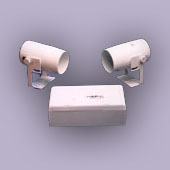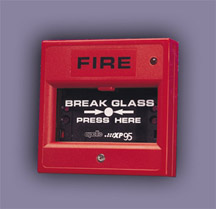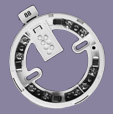|
Ionisation Smoke Detector
Air in the
dual sensing chambers is irradiated to produce ions that
travel to the positive and negative electrodes, creating
a current flow. As smoke enters the outer chamber, the
flow drops and voltage increases. The voltage is
measured and an analogue signal is converted to digital
for transmission to the control equipment.
For
important technical information regarding
sensitivity to air movement, please click
here.
|
 |
|
Optical Smoke Detector
The XP95 optical
detector uses an internal pulsing LED and a photo-diode
at an obtuse angle. In the event of smoke entering the
chamber, the light pulse from the LED will be scattered
and registered by the photo-diode. A signal is generated
and transmitted digitally to the control
equipment.
|
 |
|
Heat Detector
The XP95 heat detector
has a low air-flow resistant case for good contact
between the sensing thermistor and the surrounding air.
Temperature is measured by a single thermistor network
which gives a voltage output proportional to the
external air temperature. The signal is processed and
transmitted to the control equipment.
|
 |
|
Multisensor Detector
The XP95
multisensor detector contains an optical smoke sensor
and a thermistor temperature sensor whose outputs are
combined to give the final analogue
value.
|
 |
|
Beam Detector
The XP95 beam detector
comprises three parts: a transmitter, a receiver and an
interface. The detector has been designed to protect
large, open spaces.
To find out more, visit the
Beam Detector
page.
|
 |
|
Flame Detector
The XP95
flame detector is sensitive to low-frequency, flickering
infra-red radiation emitted by flames during combustion.
It is designed for use in large areas that require a
detector to give a fast response in potentially dusty or
highly flammable environments.
To
find out more, visit the XP95 Flame Detector
page.
|
 |
|
Manual Call Point
When operated,
the manual call point interrupts the polling cycle and
can report its address in under 0.2
seconds.
|
 |
|
Sounders
There are two
types of loop-powered sounder available, one ceiling
mounted (85dB) and one stand-alone (100dB).
To
find out more, visit the Sounders
page.
|
|
Bases
A wide range of compatible
bases is available. Detectors fit into bases one way
only, without snagging, and require clockwise rotation
without push force to be plugged in. |
 |
| |